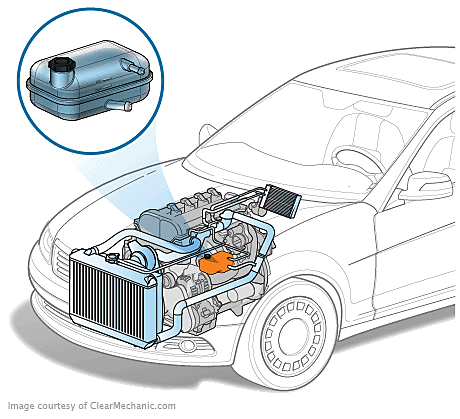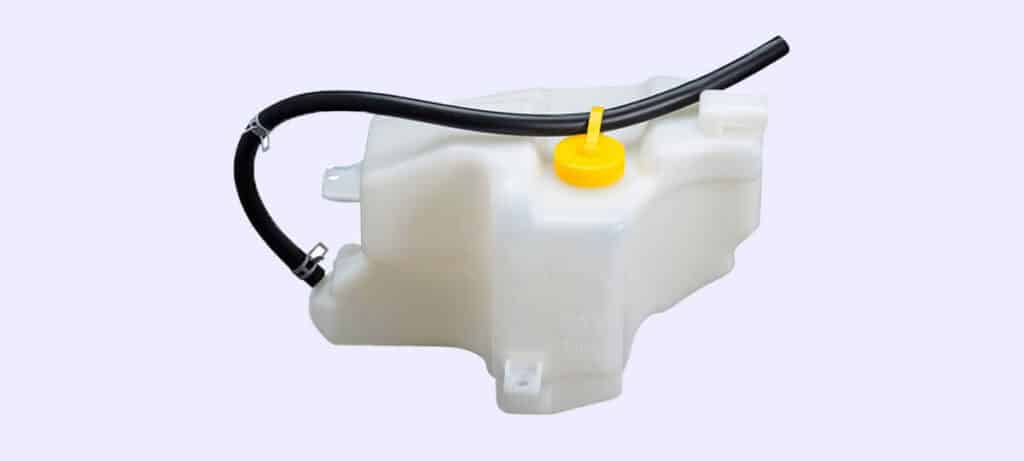If you’re experiencing issues with your car’s cooling system, such as overheating or coolant leaks, a faulty coolant expansion tank may be the culprit. In this article, we’ll take a closer look at what a coolant expansion tank is, how to recognize signs of a faulty tank, and how to replace it.
What is a Coolant Expansion Tank?
A coolant expansion tank, also known as a coolant reservoir, is a small plastic or metal tank that is located near the radiator. It serves as a storage and overflow container for the coolant in the engine, allowing for expansion and contraction as the temperature changes.

How Much Will it Cost to Replace a Coolant Expansion Tank in Canada?
The cost of replacing a coolant expansion tank in Canada can vary depending on the make and model of your vehicle, as well as the mechanic you choose. On average, you can expect to pay between $150 and $400 CAD for parts and labour. The labour time can take anywhere from 1 to 2 hours depending on the complexity of the repair.
What are the Symptoms of a Faulty Coolant Expansion Tank?
Symptoms of a faulty coolant expansion tank may include:
1. Coolant leaks: Visible signs of coolant leaking around the expansion tank or pooling beneath the vehicle.
2. Overheating: A cracked or leaking tank can lead to coolant loss, causing the engine to overheat due to insufficient cooling.
3. Low coolant warning light: If the coolant level drops due to a leak, the low coolant warning light may illuminate on the dashboard.
4. Discolored or contaminated coolant: A damaged tank can allow contaminants or rust particles to enter the coolant, which can cause discoloration or an oily appearance.
5. Frequent need to add coolant: If you frequently need to top off the coolant, it could indicate a leaking expansion tank.
6. Cracks or damage on the tank: Visible cracks, bulges, or damage on the surface of the coolant expansion tank.
7. Collapsed or damaged hoses: A faulty expansion tank may not properly regulate pressure, leading to collapsed or damaged coolant hoses.
How Long Does a Coolant Expansion Tank Last?
A coolant expansion tank can last anywhere from 60,000 to 100,000 kilometers or longer, depending on driving habits and maintenance. However, it’s important to keep an eye out for signs of wear and tear and address any issues promptly to avoid further damage to the cooling system and other components.
How Does a Coolant Expansion Tank Become Defective?
A coolant expansion tank can become defective due to various reasons, including:
1. Age and wear: Over time, the plastic material of the coolant expansion tank can become brittle and weak, leading to cracks and leaks.
2. Thermal stress: Constant heating and cooling cycles can cause the tank’s material to expand and contract, eventually leading to structural failure.
3. Chemical degradation: Coolant additives can break down over time, causing the coolant to become acidic, which may corrode the tank from the inside.
4. Physical damage: Accidents or contact with road debris can cause damage to the tank, leading to cracks and leaks.
5. Manufacturing defects: Poor quality materials or manufacturing processes can result in a weak or defective coolant expansion tank.
6. Improper installation: Incorrect installation or overtightening of fittings can cause stress on the tank and lead to leaks or cracks.
How Can a Faulty Coolant Expansion Tank Affect Other Systems in the Car?
• Engine overheating: A faulty coolant expansion tank can lead to a loss of coolant, causing the engine to overheat and potentially damaging engine components.
• Reduced performance: An overheating engine may cause reduced performance, as the engine management system may limit engine output to prevent further damage.
• Damage to cooling system components: A leaking coolant expansion tank can cause damage to other cooling system components, such as the radiator, water pump, and hoses.
• Increased emissions: An overheating engine can lead to increased emissions, as the engine’s efficiency is compromised and the optimal air-fuel mixture may not be maintained.
• Potential for engine failure: Prolonged driving with a faulty coolant expansion tank can lead to severe engine damage and possible engine failure.
• Safety risks: An overheating engine can increase the risk of a fire, posing a danger to the vehicle’s occupants and other road users.
Is it Safe to Drive with a Faulty Coolant Expansion Tank?
Driving with a faulty coolant expansion tank can be risky, as it can lead to engine overheating and potential damage. The coolant expansion tank plays a crucial role in the cooling system by providing a place for the coolant to expand and contract as the engine heats up and cools down. A damaged or leaking tank can lead to a loss of coolant, which may cause the engine to overheat, putting your vehicle at risk of serious damage and potentially resulting in expensive repairs.
While it might be tempting to continue driving with a faulty coolant expansion tank, it is best to address the issue as soon as possible. Overheating can cause irreversible damage to your engine’s components, such as the head gasket, cylinder heads, or even the engine block. Moreover, driving with a compromised cooling system can be dangerous, as it can lead to sudden engine failure or even a fire. To ensure your safety and the longevity of your vehicle, it is recommended that you have a faulty coolant expansion tank inspected and replaced by a professional mechanic.
How Can I Make My Coolant Expansion Tank Last Longer?
Here are some tips to help prolong the life of your coolant expansion tank:
• Regular maintenance: Follow the manufacturer’s recommended maintenance schedule to ensure all components, including the coolant expansion tank, are in good condition.
• Avoid extreme conditions: Avoid driving in extreme temperatures and conditions whenever possible, as these can cause damage to the cooling system and other components.
• Address issues promptly: If you notice any signs of a faulty coolant expansion tank, such as coolant leaks or low levels, address them promptly to avoid further damage.

Conclusion
A coolant expansion tank is a crucial component of your car’s cooling system, and a faulty tank can lead to costly repairs and engine damage. If you notice any signs of a faulty coolant expansion tank, it’s important to address the issue promptly to avoid further damage to the cooling system and other components. With proper maintenance and care, you can help prolong the life of your coolant expansion tank and keep your car running smoothly.
Next Steps
Book Your Coolant Expansion Tank Replacement Service
The service most frequently booked by those who read this article is Coolant Expansion Tank Replacement. Uchanics’ expert technicians make the process even more convenient by bringing the service right to your doorstep. We perform this job at your home or office, covering over 40 cities in Ontario, including Toronto, Mississauga, Brampton, Oshawa, Ajax, Scarborough, and more. Our commitment to excellence has earned us more than 700 glowing 5-star reviews. Choose Uchanics for your Coolant Expansion Tank Replacement and experience unparalleled convenience and top-quality service.
